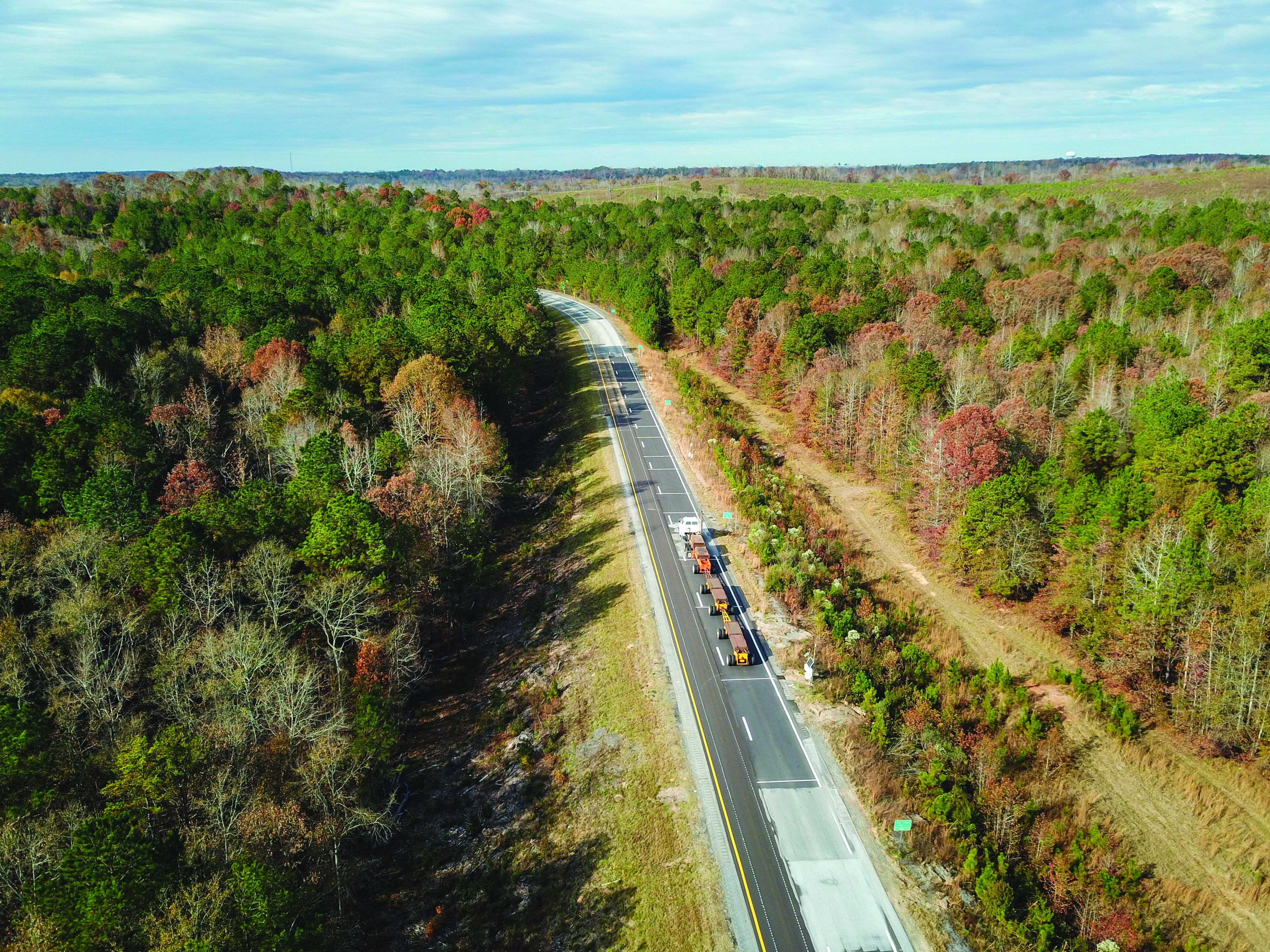- Fall 2024
Previews of the 9th NCAT Test Track research cycle

It’s 2024. A 21st century year divisible by three. Otherwise known as the start of a new Test Track research cycle! This is the beginning of the 9th Test Track cycle to be exact. However, unlike the previous 8 cycles, this one has a very different feel to it. First and foremost, Buzz Powell has retired and is no longer at the helm of the NCAT Test Track. Not seeing him around as much during this hectic time is a bit strange. But Buzz’s absence is not the only difference at NCAT. We have new faces all around the track, the main lab, and at the contractor’s plant. Some are experiencing Test Track reconstruction for the first time, and some, like me, are serving in new roles. We’ve all had to learn quickly, and our team has risen to the challenge. It’s been a pleasure being a part of this exciting time.
- Nathan Moore, Assistant Director for Test Track Research
Innovative Solutions to Practical, Local Problems
A lap around the Test Track can feel like a brand-new world every 200 feet. Each section is meticulously planned and constructed to mimic real-world conditions as closely as possible so that the sponsor can implement the findings without hesitation.
Consistent with NCAT’s mission statement, this research cycle features a variety of experiments designed to improve the safety, durability, and sustainability of asphalt pavements. Experiments include BMD overlays on cracked underlying pavement layers simulated with saw-cutting, new stabilization methods to improve weak bases and expansive subgrade materials, enhanced friction asphalt mixes, and other innovative and exciting ideas. Six different binder grades and aggregates from ten different states were used during this reconstruction. The variety of experiments ensures that anyone interested in asphalt pavements will find something out on the Track to get excited about!
Here is a quick preview of what to expect from the 2024-2027 9th NCAT Test Track research cycle.
Cold-In-Place Recycling
Three new Cold Central Plant Recycling (CCPR) sections were placed on the Test Track this summer. One section, sponsored by the Virginia Department of Transportation (VDOT), re-recycled a previously placed CCPR section to investigate the recyclability of these pavement layers. A similar section was constructed in 2021, also sponsored by VDOT, and will allow for head-to-head comparisons.
Collaborative Aggregates sponsored the construction of a rejuvenated CCPR mix using an emulsion with Delta S on the Test Track offramp. This CCPR mix will remain as the final riding surface to push the limits of these mix types. Finally, a CCPR mix with SoyLei Innovative Products’ soybean-based rejuvenator was developed and placed on the Track. A rejuvenated 50% RAP mix will be placed on top in a six-inch lift.
Asphalt Mixture Additives
Continuing with the additives theme from 2021, two new sections with forms of recycled plastics and three sections with ground tire rubber will be featured. NCAT will test a graphene-enhanced recycled plastic from Universal Matter Inc. and an engineered recycled plastic from LyondellBasell. These sections will be placed adjacent to the two plastic-modified mix sections from 2021.
South Carolina DOT (SCDOT) is investigating ground tire rubber (GTR) use in SMA mixes. VDOT elected to place a control BMD mix on top of one of the previously mentioned CCPR sections and a rubber-modified BMD mix on the other for a head-to-head comparison. Finally, the Test Track welcomes a new sponsor, the Arkansas DOT (ARDOT), who will evaluate a version of a dry-added modified asphalt rubber gap-graded mix that they are considering as a means to mitigate reflective cracking from underlying concrete pavements.
Friction and Texture
Three new test sections will have friction and/or texture as their primary focus. The North Carolina DOT is considering a new high-texture, dense-graded asphalt mixture for their specifications and has sponsored a preliminary version of that mix type on the Test Track for this cycle. NCDOT is also assessing the use of longitudinal grooving to enhance the texture of a fine-graded surface mix that was placed in 2021 The West Virginia Division of Highways (WVDOH) is investigating the friction performance of a thin-lift overlay with calcined bauxite. Using the Three-Wheel Polishing Device (TWPD) during design, NCAT developed a mix intended to have enhanced friction compared to typical asphalt mixes. The Kentucky Transportation Cabinet is continuing its 2021 friction-focused test sections, which will be shotblasted. Friction performance will be monitored to assess the life-extension benefit at various friction levels.
Soil Stabilization
NCAT is breaking new ground in this research cycle by exploring an experiment with an enzyme treatment for soil stabilization. This test section, sponsored by Verde Resources, includes over five feet of expansive subgrade soil and base. Verde’s enzyme treatment technology significantly reduced the amount of cement and lime necessary for soil stabilization compared to a similar section sponsored by the Mississippi DOT in 2018.
Sustainability
In addition to a CCPR layer, SoyLei’s experiment features a 50% RAP mix with their soybean-based rejuvenator. Thus, in their 12-inch asphalt pavement cross-section, 75% of the materials are recycled! Furthermore, SoyLei is sponsoring a spray-on rejuvenator to investigate the life extension benefits and mixture quality of their existing section. The Oklahoma DOT (ODOT) is also investigating spray-on rejuvenators as they consider this type of treatment for pavement preservation. Similarly, BASF is testing their crack seal and fog seal products on the NCAT Test Track this cycle as they continue pushing the needle forward regarding asphalt modification.
Durability and Performance
The Georgia DOT (GDOT) sponsored two test sections to evaluate the suitability of different binder grades and mix types to mitigate top-down cracking. Mississippi DOT seeks to improve open-graded friction courses (OGFC) on their highways by testing a mix designed for improved durability compared to the typical OGFC mixes while remaining permeable. Tennessee DOT is assessing the effectiveness of its provisional Balanced Mix Design (BMD) specification using asphalt mixes containing lower-quality aggregates from western Tennessee. Recognizing that these mixes may require different performance thresholds, a typical mix was placed alongside one with higher BMD values, achieved by incorporating a rejuvenating Warm Mix Asphalt (WMA) additive and using a lower production temperature. This side-by-side comparison aims to establish new BMD thresholds tailored for mixes from this region of the state. Finally, Oklahoma DOT sponsored a test section that was saw cut to mimic a pavement with extensive block cracking. A BMD mixture at the edge of their specification regarding RAP content and binder grade was placed on top to evaluate how well mixes designed under ODOT’s BMD specification will withstand harsh traffic and environmental conditions.

Contact Nathan Moore at ndm0005@auburn.edu for more information about the Test Track and NCAT's research.